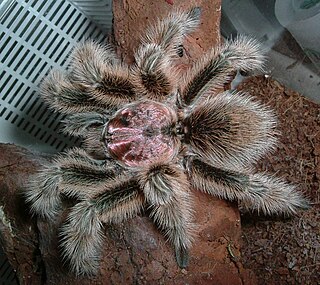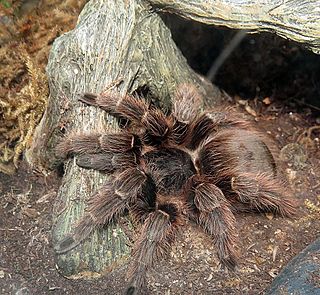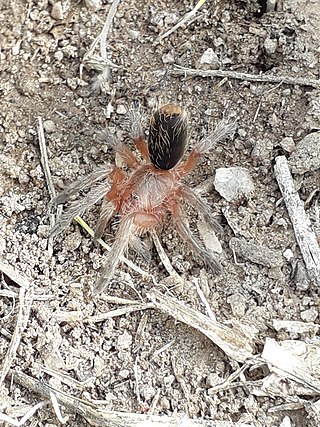
Avicularia is a genus of the family Theraphosidae containing various species of arboreal tarantulas. The genus is native to Panama, the Caribbean and tropical South America. Each species in the genus has very distinguishable pink foot pads.

Grammostola is a genus of South American tarantulas that was first described in text by Eugène Louis Simon in 1892. These medium- to large-sized spiders are native to tropical South America, and are usually brown in color, with pinkish or orangish-red hairs. The very docile Chilean rose tarantulas are popular as a beginner's spider among tarantula enthusiasts.
Cândido Firmino de Mello-Leitão was a Brazilian zoologist who is considered the founder of Arachnology in South America, publishing 198 papers on the taxonomy of Arachnida. He was also involved with education, writing high-school textbooks, and contributed to biogeography, with essays on the distribution of Arachnida in the South American continent.

Diplura is a genus of South American curtain web spiders that was first described by C. L. Koch in 1850. It is found in South America and Cuba belonging to the subfamily Diplurinae. They possess a lyra on their prolateral maxillae. Diplura species can be distinguished from Trechona sp. by the number of setae on this lyra. They differ from Harmonicon sp. by the leg formula and the shape of the lyra bristles.

Tarantulas comprise a group of large and often hairy spiders of the family Theraphosidae. As of August 2022, 1,040 species have been identified, with 156 genera. The term "tarantula" is usually used to describe members of the family Theraphosidae, although many other members of the same infraorder (Mygalomorphae) are commonly referred to as "tarantulas" or "false tarantulas". Some of the more common species have become popular in the exotic pet trade. Many New World species kept as pets have setae known as urticating hairs that can cause irritation to the skin, and in extreme cases, cause damage to the eyes.

Cyriocosmus is a genus of tarantulas that was first described by Eugène Louis Simon in 1903. They are small to medium spiders, with a bicolored or one same color carapace.
Cyclosternum is a genus of tarantulas that was first described by Anton Ausserer in 1871.

Acanthoscurria is a genus of tarantulas that was first described by Anton Ausserer in 1871. They are found throughout South America including the countries of Argentina, Bolivia, Brazil, Ecuador, French Guiana, Guyana, Paraguay, Peru, Suriname and Venezuela, plus into the Windward Islands West Indies,.

Sericopelma is a genus of tarantula, found in Central America from Nicaragua to Panama. The limits of the genus and its distribution have long been confused; it is closely related to the genus Aphonopelma. Sericopelma species are among the largest found in Central America. They can be kept as pets, although at least one species has been described as "very aggressive".

Lasiodora is a genus of tarantulas that was first described by Ludwig Carl Christian Koch in 1850. They are often very large; body lengths of up to 25 centimetres (9.8 in), including the legs, are not unusual. They are found in South America, including the countries of Brazil, Bolivia, Costa Rica, Argentina and Uruguay.

Acanthogonatus is a genus of South American mygalomorph spiders in the family Pycnothelidae. It was first described by Ferdinand Anton Franz Karsch in 1880. Originally placed with the brushed trapdoor spiders, it was transferred to the funnel-web trapdoor spiders in 1985, then to the Pycnothelidae in 2020.

Eupalaestrus is a genus of South American tarantulas that was first described by Reginald Innes Pocock in 1901.
Tmesiphantes is a genus of Brazilian tarantulas in the subfamily Theraphosinae that was first described by Eugène Louis Simon in 1892. The genera Magulla and Melloleitaoina were brought into synonymy in 2019.

Cyrtopholis is a genus of tarantulas that was first described by Eugène Louis Simon in 1892.

Hapalopus is a genus of tarantulas that was first described by Anton Ausserer in 1875.

Plesiopelma is a genus of South American tarantulas that was first described by Reginald Innes Pocock in 1901. Plesiopelma species are particularly abundant along mountainous ranges, frequently living under stones. Both males and females live in silk tubes under stones with aggregate spatial distribution. The walls of these tunnels are covered by waterproof silk, protecting them from floods. In addition, there is a uniform saturated microclimate inside the tunnel, which protects the spiders from dehydration.

Vitalius is a genus of South American tarantulas that was first described by S. Lucas, P. I. da Silva Jr. & Rogério Bertani in 1993.
Homoeomma elegans is a species of spiders in the family Theraphosidae. It is found in Argentina.














